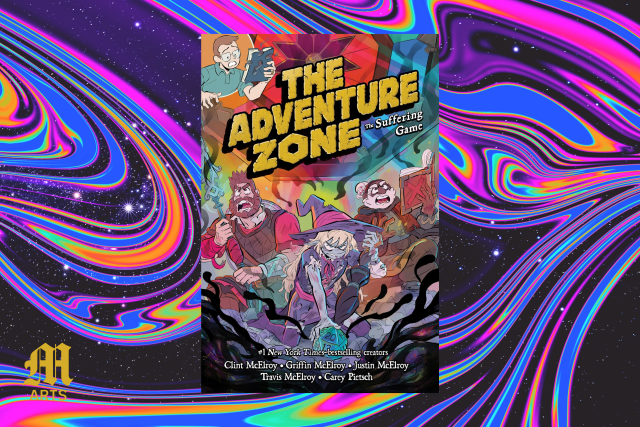[ad_1]
In “The Adventure Zone: The Suffering Game,” the sixth installment of the New York Times best-selling graphic novel series, twin necromancers-slash-game show hosts Lydia and Edward step onto the page like glam rock gods, clad in caped bodysuits and tights. These glitzy liches run Wonderland, a supernatural game show that promises to grant its winners whatever their hearts desire.
Unfortunately, the game show is more “Saw” trap than “Wheel of Fortune.” Advancing in the game forces participants to sacrifice a part of themselves, from digits to limbs to years off their lives. Hungry monsters wait behind every corner, ready to snap up the unsuspecting contestant (Ken Jennings, take notes!). Enabling it all is the Animus Bell — a magical item imbued with power over life and death.
Enter adventurers Magnus, Merle and Taako. Their quest? Survive Wonderland, defeat Lydia and Edward and escape with the Grand Relic. It’s an old hat for the trio by now, who have been stealing magical weapons of mass destruction like the Animus Bell since, like, book one. However, the appearance of a red-robed figure from their past throws a wrench in their plans, one that forces them to question their loyalty to their quest and employer.
“The Adventure Zone” is comedy and fantasy at its finest (and most crass). The graphic novel series adapts the podcast of the same name, which stars the McElroy family — brothers Justin, Travis and Griffin alongside their father Clint — playing the popular tabletop roleplaying game Dungeons & Dragons. Artist Carey Pietsch and writer Clint McElroy began adapting the series with “Here There Be Gerblins” in 2018, with Griffin McElroy joining as co-writer for subsequent releases after the fifth novel. The McElroy brand of humor — always irreverent, occasionally witty and alarmingly referential — along with Pietsch’s character design and glossy colors have made the series a multiple best seller.
This triumph only continues in “The Suffering Game.” Combining two story arcs and dozens of hours of audio from the original show, adapters Griffin and Clint have vastly improved upon the original narrative. Longtime listeners may notice that the adaptation has wisely not included a whole subplot centering a rival group of adventurers. Likewise, extraneous fight scenes that took up whole podcast episodes have been cut entirely. Mindless repetition of the podcast storyline is sidestepped, leaving crucial moments with more time and weight. The result is far better paced than the previous adaptations from the McElroys, which often felt a bit compressed and rushed.
This brevity keeps the story moving at a brisk pace. Moments after escaping Wonderland more or less intact, Merle, Magnus and Taako are thrust into an even greater threat. Without too many spoilers, our intrepid heroes have been lied to by their enigmatic employer, Lucretia, and their confrontation is one of cosmic proportions. Questions raised in the very first book are finally answered and the stage is set for the climatic finale, to be released sometime next year. Scenes move from witty side jokes and visual gags (including one particularly memorable sequence involving a buck-naked Magnus and a rather well-placed… sword) to dramatic, close-angle monologues with remarkable deftness. It’s a ratcheting of tensions the book series had yet to grapple with, and one that it navigates rather well.
For its short length, the book does sometimes feel cluttered. Pietsch is a master of character design and color, but her panel compositions can be busy to the point of obstruction. A larger page size might help alleviate some of the problem, but unfortunately “The Suffering Game” is locked down at a standard trade paperback size. This renders her pages hard to read: Loaded as they are with detail and emotion, the action scenes are crowded, with the line of motion through each panel hard to follow.
Still, Pietsch makes Wonderland and its inhabitants as glamorous as they are deadly. Character design has long been a strong suit of the series, and while her scenes are still awash with detail, the emotional register has been broadened. Her close shots are clearly a favorite of hers during tense sequences, and for good reason. In these large inset panels, each gooey tear or billowing shirt is lovely and fluid. It’s simply a shame that the publisher chose not to play to Pietsch’s strengths by giving her more room to breathe.
“The Suffering Game” is an improvement on both the original story arc of the podcast and on the usual formula of the graphic novel adaptations. The series finale releases next year, and the stage has been set; all questions are about to be answered; a final battle awaits our intrepid band of vagabonds (as is the way of things). With the smash success of “The Suffering Game,” there’s nowhere to go but up.
Daily Arts Writer Alex Hetzler can be reached at alexhetz@umich.edu.
Related articles
[ad_2]
Source link











